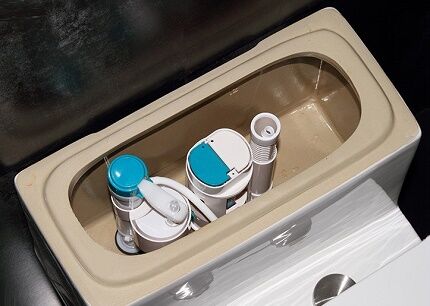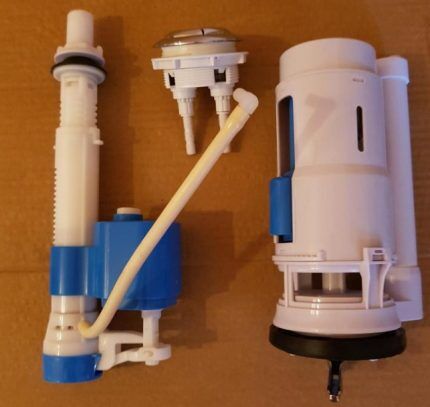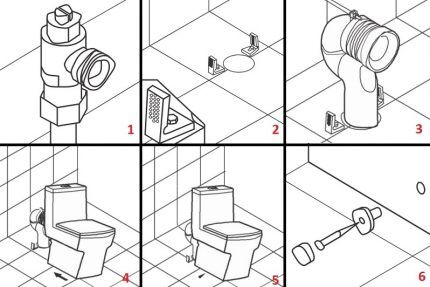Monoblock toilet: device, pros and cons, how to choose the right one
In addition to ergonomics and reliability, the development of all types of plumbing fixtures is necessarily based on maximum tightness and ease of installation.As a result of inexhaustible attempts to reduce the number of connections, a monoblock toilet appeared, the bowl of which is located in the same housing with the flush cistern.
Before you decide to buy monolithic plumbing, you need to know about its advantages and disadvantages, don’t you agree? We will help you make an informed choice.
The article details the arguments for and against monoblocks, provides practical recommendations for choosing the optimal model, and identifies the best manufacturers of such plumbing fixtures. Step-by-step instructions describing all stages of installation will help you install and connect a new toilet without the help of a plumber.
The content of the article:
Specifics of a monolithic toilet
Monoblock toilets occupy a separate niche in the range of plumbing fixtures. Outwardly, they are very similar to their compact counterparts, with which they directly and structurally have many common features. By analogy, the tank is not hidden; a floor installation is used.
Unlike compact-type toilets, in the monoblock version, the water intake and outlet devices are located in a one-piece housing.
As a result of the innovations, installation has been simplified, which greatly affects its quality indicators. In addition, components that inevitably create the threat of eternal leaks have been eliminated.
Based on consumer demand, monoblocks are still noticeably inferior to compacts. It is possible that the reason lies in the relatively recent appearance of this type of product on the market.
And manufacturers are not too willing to take on the production of monolithic plumbing fixtures due to a number of difficulties in manufacturing and transportation.
This is probably why monoliths are more expensive than their compact counterparts, but much more interesting in terms of design. There are suspicions that they are purposefully produced for adherents of creative plumbing fixtures who spare no expense in purchasing expensive exclusives.
Although you can find quite inexpensive offers in the product line.
Advantages of combining tank and bowl
The original design is only one of the trump cards of monoblock plumbing.
To the list of compelling arguments in favor of its acquisition, it is necessary to add a few more convincing facts:
- Priority package. To operate monoblocks, you do not need to install a separate tank; you do not need parts to connect it to the toilet and no seals for connections.
- Ergonomic priorities. Monoblocks, as products that do not fall into the category of cheap products, are thoroughly and comprehensively thought out for ease of use.
- Easier care. Materials that are resistant to the formation of sediment and the accumulation of contaminants are used in the manufacture. This is also prevented by the glazed shell of the plumbing fixtures and the form that prevents deposits.
- Wear resistance. Monolithic plumbing fixtures are made from high-strength sanitary ware; external removable parts are made of duroplast, which retains its original color throughout the entire operational period.
- Economic advantages. Monoblock models are thoroughly thought out in terms of economical water consumption; complete flushing is carried out with an extremely minimal volume.
Most monoblock models are equipped with seats with devices for smooth movement of the lid - microlifts. To gently lower it onto the rim, the user does not need to make any effort. If desired, you can choose another toilet seat.
Impacts and slams on the bowl are eliminated, which should also be included in the collection of facts that extend the service life of plumbing fixtures.
An undeniable advantage is the complete setup of systems in the factory. Monoblock plumbing fixtures go on sale only after numerous meticulous performance tests have been carried out.
The design, which has undergone scrupulous control, almost never causes any complaints.
Weighted assessment of shortcomings
The main disadvantage of monoblock toilets is the price, which makes you think about choosing another model. However, the cost gap between them and compacts is not that great.
Of course, molding and drying non-standard products requires increased investment on the part of the manufacturer, but these nuances are hardly of interest to the buyer.
On the other hand, monoblocks work flawlessly for 20 years or more, without forcing owners to resort to the help of plumbers to fix breakdowns. They rarely need to replace seals at the points of connection to communications; they are equipped with reliable drain fittings. True, the gaskets will still have to be changed periodically.

Typical toilet flushing system problems may arise. Despite the manufacturers’ sincere and documented assurances of its impeccable operation for 10 years, no one is protected from such failures.
Repair tank fittings, combined with a bowl, is unlikely to work. The drain assembly will most likely have to be completely replaced. According to experienced plumbing professionals, it is better to immediately purchase a spare set when purchasing a toilet.It’s not a fact that such a device can be easily picked up a decade later.
Production leaders in the monoblock segment
The leading position in the ranking of monoblock manufacturers is quite rightly occupied by an Italian company Laguraty. The line of this brand includes models of laconic and luxurious design, made in a non-trivial and classic style.
It is this company that offers original options with tanks in the shape of a soccer ball or a flower vase. Bathroom equipment from designer Giovanni Laguarti is produced in Italy and China.
The parent company strictly monitors the quality of products supplied to the market by Chinese structures, because bears overall responsibility for the serial production of products bearing the specified brand logo.
Naturally, a product produced by Italian enterprises will cost significantly more than a Chinese-made equivalent. Note that the second option is not inferior in quality to the first, so it makes no sense to overpay for a purely Italian product.
Proven technologies are used in the production of Laguraty monoblocks.The company's patented casting and firing processes guarantee long service life of about 25 years. The production uses exclusively natural raw materials that do not pose a threat to the environment.
Plumbing faience is coated with a heavy-duty glaze that prevents contamination and wear. The package includes a durable plastic seat with a micro-lift that gently lowers the lid onto the bowl.
The Laguraty assortment includes modifications with horizontal and vertical drainage, which allows you to select plumbing fixtures for any sewerage installation scheme.
There is a half shelf around the circumference of the bowl against the splash; the design of the circular drain eliminates the appearance and spread of bacteria on the sanitaryware.
The company is no less active in the production and supply of monoblocks to the market Royalking Sanitary Ware SSWW, whose production plants are located in Germany.
Unlike the Italian brand described above, the German company does not specialize in the production of monoblock sanitary ware, but devotes enough space to it in its assortment.
Solid monoblock structures of the SSWW brand are covered on both sides with a dirt-proof glazed nano shell, which prevents surface contamination, rust deposition and limescale deposits.
Firing of sanitary ware blanks is carried out using our own technology. The monoblock tanks are equipped with unique fittings from Geberit and seats with microlifts.
Water for flushing comes from holes located around the circumference of the bowl. There are two modes of water consumption for flushing, providing an opportunity to save water consumption.
The Spanish manufacturer offers customers an interesting and practical new product Roca. A new word in his developments is a monoblock toilet combined with a washbasin.
In addition to the stylish design and spectacular shape of the model ROCA W+W 893020001 The water saving aspect has been thoroughly thought out. A model created on a similar principle is in the Laguraty line of monoblocks, its serial number is 8074.The tank has a monolithic design and has two compartments, one of which is designed to collect water drained from the sink.
The second compartment of the tank is directly connected to the water supply, so that there are no difficulties with flushing if the volume in the first section of the tank is insufficient.
The excellent design of the monoblock system is solidly complemented by high quality characteristics, the stability of the plumbing and the strength of the material.
By analogy with other representatives of the segment, the toilet is equipped with an ergonomic seat with a microlift. Combining three separate objects into a monoblock provides the opportunity to significantly increase the free space in the bathroom.
A Swedish company is replenishing the market with very worthy monoblock sanitary ware Gustavsberg, which guarantees impeccable product service for a quarter of a century, although it does not please with its affordable price.
Italian models of the brand are in demand Olympia, Turkish plumbing from VitrA. Both manufacturers guarantee the use of monoblocks without problems for at least 10 years.
The company promises a warranty period of 5 years for bowls and 3 years for fittings Arcus (China), producing a wide range of monoblock toilets. The assortment includes products in numerous shades of white, colored, black models and monoblocks with elegant painting.
Products of this brand are attractive due to their affordable price and the company’s diligent desire to maintain high world-class quality standards.
Available for sale smart toilets, manufactured according to the monoblock principle. Multifunctional smart plumbing is equipped with systems for bidet operation, drying, and automatic lid movement. Control and configuration are carried out using a remote control.
Features of monoblock installation
Before paying, the buyer of a monoblock toilet needs to check the availability of technical documentation with a translation of the instructions into their native language and the complete set of the sales offer.
The standard kit includes the monoblock itself, fittings for drawing water into the tank and flushing, fasteners for fixing to the floor and a seat with a lid.

Monoblock plumbing fixtures, which are quite heavy, are not recommended to be installed on a freshly poured concrete floor. The base must be strong, reliable, repaired and leveled, and in the case of concrete, it must be sufficiently hardened for installation.
Traditionally, installation work should be preceded by fitting and marking of holes for fastening.
To do this, we first install the monoblock in the place chosen for it, determine the option for connecting the outlet pipe to the sewer system, and mark the attachment points in the floor.
Upon completion of the preparatory activities, we act in accordance with the following algorithm:
- Forming holes. For drilling, you will need an 8 mm drill; you need to drill to a depth of 5 cm. After drilling, clear the holes from dust and insert dowels into them.
- Installation of drain fittings. Unscrew the nut with the seal from the valve that controls the filling of water. We immerse the valve in the tank and secure it with a nut. We insert a long section of pipe into the overflow cylinder, which is technically connected to the drain valve.
- Drain button attachment. We place the push button in the corresponding recess in the tank lid. We make sure that the buttons for normal and economical draining are located in the place specified by the manufacturer.
- Connection to sewerage. We install the monoblock in place, connect the outlet pipe to the sewer outlet corrugated pipe.
- Temporary fixation. After leveling the toilet, if necessary, screw the screws into the dowels installed in the floor without force.
- Water supply connection. Before connecting to the water supply, check that the supply valve nut is securely fastened. Connect the hose.
- Final fastening. After connecting to the communications, tighten the screws with force and cover the attachment points with decorative plugs. We fill the joint line of the toilet with the floor with sealant.
Having secured the toilet, install the seat and adjust the water supply by changing the height of the valve or turning the adjusting screw. We set the large drain volume using the adjusting ring, and set the small volume by moving the weighing pan.
Tips for potential buyers
Future owners of monoblock plumbing fixtures should carefully prepare for the upcoming purchase.
Close attention should be paid to:
- Release type. Monoblocks are produced with horizontal or vertical outlet. You need to find out ahead of time which system is ideal for connecting to the sewer outlet.
- User's estimated weight. It is necessary to take into account the weight of the “heaviest” family member and see in the technical documentation what the maximum permissible weight can be loaded on the structure. By the way, it doesn’t hurt to estimate the seat dimensions in reality.
- Technical complexity of the model. If the presence of a microlift, two modes of water flow for drainage and means for performing bidet functions is not of interest, there is no need to overpay for unnecessary features.
Before purchasing, be sure to check whether the technical passport matches the purchased monoblock model, whether there are all documentary annexes, including warranty obligations, a receipt and an installation manual.
An attentive buyer will definitely inspect the fittings and body of the plumbing fixtures and check the operation of the seat roof with a microlift. In order for a non-standard toilet to successfully fit into the interior picture, it is advisable to purchase a sink made in the same style.
If you still cannot make a final purchase decision, we recommend that you read the articles on choosing a toilet:
- How to choose a wall-hung toilet: which is better and why + review of manufacturers
- Corner toilet with cistern: pros and cons, diagram and features of installing a toilet in the corner
- Types of toilets by technical characteristics and design
Conclusions and useful video on the topic
Review of the model from the Italian manufacturer:
The video presents a Chinese-made monoblock:
The monolithic toilet has probably not yet become a common attribute of domestic bathrooms, but for our realities this is a very useful innovation. Quite a few people still live in apartments with small hygienic rooms. For them, monoblocks are a true godsend.
Do you have anything to add, or do you have questions about the selection and installation of monolithic toilets? You can leave comments and participate in discussions about the publication. The contact form is located in the lower block.






My wife got on my nerves, she wanted a monoblock toilet, and that’s it. It’s beautiful, I don’t argue, but the price is quite expensive. As a result, we found an acceptable price option, and I decided to install it myself. I spent almost the whole day, I had never done this before, looking at how to mount it correctly according to the instructions. During the installation process, the only thing that made me happy was the prospect of not having to worry about gaskets and leaks for about 15 years.
We are also thinking about installing a monoblock at home.Just one thing that confuses me. Everyone writes in unison that there will be no problems characteristic of classic “compact toilets” - no leaks, no worn-out gaskets, etc. But I don’t think that monoblocks are eternal. And I would really like to know whether ordinary plumbers, regular ones, who are in the management company, can handle their repairs? Or will you have to look for a specialist or company whose services will cost a pretty penny? I myself don’t understand these things and I’m unlikely to understand them in the future.
Sergey, its internals are practically no different from a regular compact, so super qualifications from a plumber are not required.
We have been using it for 18 years. We bought a used one, changed the siphon only once, ours fit. Excellent toilet, I feel sorry for the mechanic, when they changed the pipes in the house, they stood on the seat. It burst and, of course, cannot be replaced: ours is not earthenware, but some kind of dense plastic. I don’t know what to call it, but it’s big and convenient; when I renovate, I’ll only buy the same one.